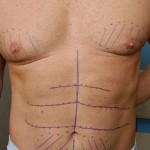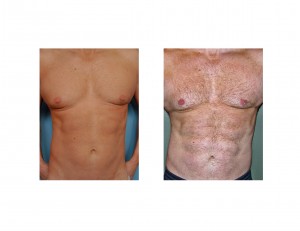Background: The most common area for liposuction on the body is the abdomen for both men and women. It is done very successfully for making a round belly flatter and providing some shape to an often rotund waistline. While one can never make a round abdomen into a flat and sculpted athletic one, removal of a few liters of fat aspirate can go a long way to improvement that defies what most can not achieve with diet and exercise.
Some patients, however, want more than just a flattening effect and desire a muscular-looking result. A well-defined abdomen is one that not only tapers in on the sides but shows an outward appearance of the underlying abdominal muscles. The abdominals consist of 6 muscles that extend from the ribs to the pelvis at various locations. These are the internal and external obliques, the transversalis and the rectus abdominus. While all play important muscular roles, paired rectus abdominus muscles are the most superficial and it alone accounts for the ‘six-pack’ look that many desire.
The vertically-oriented rectus muscle are joined in the midline by the confluence of their encircling fascial sheaths. There are fibrous bands that cross the rectus muscle at three specific locations, at the umbilicus, one below the xiphoid process and one between the two. These fibrous bands do not pass through the muscle but only indent inward into the encircling sheath. These tendinous insertions is what creates the ‘six-pack’ look and even an ‘eight-pack’ look can be created in people with very low body fat. The abdominal etching technique creates a similar look by removing the overlying fat along these bands, creating visible skin indentations where the underlying inscriptions lie.
Case Study: This 43 year-old male had lost signifincat weight and worked hard to develop a more muscular body frame. While his efforts were exemplary, he desired even more results and wanted a ‘sic-pack’ abdominal look. He felt he had done what he could and wanted to pursue a liposuction etching technique to get it.



Case Highlights:
1) Abdominal liposuction can be useful for more than just volume reduction, it is also a sculpting technique as well.
2) Abdominal etching is a linear liposuction technique that over reduces fat along the inscription lines to create a ‘six-pack’ look.
3) Abdominal etching works best and only looks natural on a patient who already has a fairly lean abdomen and wants more visible muscular outlines.
Dr. Barry Eppley
Indianapolis, Indiana


